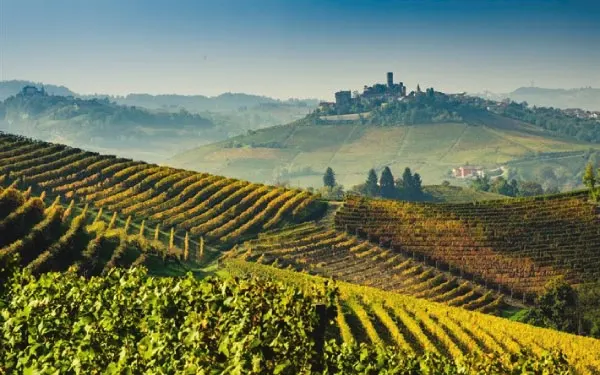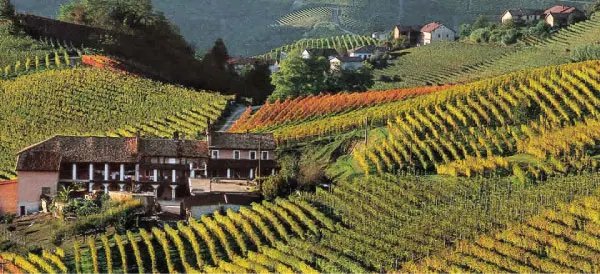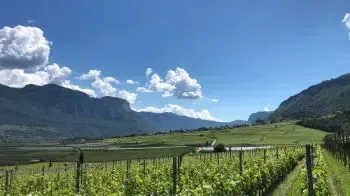The introduction and presence of wine in Italy is due to two peoples, the Phoenicians and the Greeks. The Phoenicians initially marketed wines in Sardinia and Sicily, and the Greeks were responsible for introducing new varieties of grapesand for the regular consumption of wine by the Italians.
Italy
Italy is located in south-central Europe. The territory of the country covers about 301,338 km² and has a temperate climate. With 60.6 million inhabitants, it is the 5th most populous nation in Europe and the 23rd in the world.
For much of its post-Roman history, Italy was fragmented into several kingdoms, such as the Kingdom of Sardinia, the Kingdom of the Two Sicilies and the Duchy of Milan, and was unified in 1861 after a tumultuous period in history known as " Risorgimento ".
Italy has three large areas where the various wine regions are located: North, Center and South.

Image: Italy Wine Market
Italy’s Terroir
The climate in Italy varies from region to region.
Northern Italy (Milan, Turin and Bologna) has a continental climate, while south of Florence, the climate is Mediterranean, with dry and sunny summers. The climate of the peninsula's coastal areas is very different from the interior, particularly in the winter months. These have a typical Mediterranean climate with mild winters and hot, generally dry summers.
There are notable differences in temperatures, especially during winter: in December or January it can snow in Milan, while in Naples temperatures are around 12ºC.
The soil is clay-limestone, which makes Italian wines of great quality and unique character, since this type of soil has a high capacity for retaining and draining water thanks to limestone.
Italy Wine Regions
In Italy we can find 19 wine regions, spread from North to South of the country. The Northern regions are located between the Alps and the Apennines, in the valley of the River Pó. Areas closer to the sea tend to have higher levels of precipitation, which makes the vines susceptible to fungal attacks. In the Center, the vines are planted in the valleys and hills of these mountains, which exert a moderate influence on the hot climate. The south is hot and dry, however, some vines receive help to reduce the heat.
North
- Valle d’Aosta: it has less wine production than other regions of the country, although its wines can occasionally be found in export markets. Its production is almost 70% red wine. The main grape varieties in the region are Petit Rouge, Nebbiolo, Pinot Nero, Prié Blanc and Fumin.
- Piemonte: it is best known for Barolo and Barbaresco, along with other popular red wines made from Barbera and Dolcetto, the white Gavi and the sparkling Asti. The main grape varieties in the region are Barbera, Moscato, Dolcetto and Nebbiolo.
- Liguria: it is not well known outside the Riviera because its production is very small, the second smallest in the Italian regions. Its production is mainly white wine. The main grape varieties in the region are Vermentino, Pigato (which is actually a blend of Vermentino) and Rossese.
- Lombardia: is best known for the classic method sparkling wines of Franciacorta. The main grape varieties in the region are Croatina, Pinot Nero, Chardonnay and Barbera.
- Trentino-Alto Adige: the valley of the river Adige is known for its cold climate wines with varied labels, mainly white (two thirds of its production). The main grape varieties in the region are Chardonnay, Pinot Grigio and Schiava.
- Veneto: it is best known for its Valpolicella red wine, white Soave and sparkling Prosecco. More than three quarters of this region's production is white wine. The main grape varieties in the region are Glera, Garganega, Merlot, Corvina and Pinot Grigio.
- Friuli-Venezia Giulia: is known for white wines made from varieties such as Pinot Grigio and Friulano. Produces mostly white wine. The main grape varieties in the region are Pinot Grigio, Merlot and Friulano.
- Emilia-Romagna: it is best known for the very popular sparkling red wines made from Lambrusco. The main grape varieties in the region are Trebbiano, Lambrusco and Sangiovese.
Center
- Toscana: famous for reds made from Sangiovese, especially Brunello di Montalcino and Chianti. The dominant grape variety in the region is Sangiovese, and it has the highest proportion of red wine of any region - 85%.
- Umbria: it is best known for the white wines of the city of Orvieto, and the red wines of Montefalco. The main Umbria grape varieties are Sangiovese, Trebbiano and Grechetto.
- Marche: it is known for white wines made from Verdicchio and red wines based on Montepulciano, such as Rosso Cònero and Rosso Piceno. The main grape varieties in the region are Sangiovese, Montepulciano and Verdicchio.
- Abruzzo: it produces red and white and the main grape varieties in the region are Montepulciano and Trebbiano.
South
- Molise: somewhat unknown region in the world of wine. The main grape varieties in the region are Montepulciano and Trebbiano.
- Lazio: it is best known for white wines like Colli Albani and Frascati. The main grape varieties in the region are Malvasia and Trebbiano.
- Campania: it is best known for red wines made from Aglianico, such as Taurasi, and white wines made from Falanghina, Fiano and Greco. The main grape variety in the region is Aglianico.
- Puglia: it is not well known yet, but as the quality improves, its wines arouse great interest. The main grape varieties in the region are Sangiovese, Primitivo, Negroamaro and Trebbiano.
- Basilicata: is not very well known, producing less than 0.2% of the country's total production. The main grape variety in the region is Aglianico.
- Calabria: it is probably best known for Cirò DOC. The main grape variety in the region is Gaglioppo.
- Sicília: it was once best known for its Marsala wine, although it is now more prominent for the dry wines of Etna. The main grape varieties in the region are Catarratto and Nero d’Avola.
- Sardegna: it is best known for red wines made from Cannonau and white wines made from Vermentino. The main grape varieties in the region are Cannonau (35%) and Vermentino (28%).
Types of wine in Italy
Depending on certain characteristics unrelated to the quality of the wine, we can divide Italian wines into four categories:
- Vino da Tavola: are cheaper and simpler, usually for daily consumption. They make up about 80% of Italy's wines.
- Indicazione Geografica Tipica - IGT: applied to wines made in specific geographic regions.
- Denominazione di Origine Controllata - DOC: determines from the pruning and planting system of the vineyards, maximum yield per hectare, alcohol content of wines, winemaking techniques and aging criteria.
- Denominazione di Origine Controllata e Garantita - DOCG: is attributed to Barbaresco, Barolo, Gattinara and Asti wines in Piedmont; Franciacorta, in Lombardy; Brunello from Montalcino, Carmigiano, Chianti, Vino Nobile di Montepulciano and Vernaccia di San Gimignano, in Tuscany; Albana di Romagna in Emilia Romagna; Montefalco Sagrantino and Torgiano Rosso Riserva, in Umbria; Taurasi in Campania.
With regard to the characteristics of Italian wine, we can distinguish the following:
- Classico: a denomination that differentiates some DOCs in terms of quality, for example Chianti and Chianti Classico.
- Superiore: wine that ages for at least one year before sale.
- Riserva: wine that ages for at least three to five years before sale.
- Spumante: sparkling wine, made either by the Charmat method or by the Champenoise method.
- Frizzante: slightly sparkling wine.
- Secco, Abbocado, Amabile e Dolce: defines the sugar content of the wine, which can be: dry, practically without sugar (secco); medium dry or demi-sec, with medium sugar contents (abocado and amabile); really sweet (dolce).
- Liquoroso: fortified or naturally strong wine.
- Passito: wine made from semi-dehydrated grapes (raisins).
- Ripasso: wine (Valpolicella) which, after being made, is left to rest in the fermentation lees of Amarone, gaining body, flavor and alcohol content.

Image: Donatella Cinelli Colombini
Characteristics of Italian Wines
Italy offers a wide variety of flavors, styles, types, and even colors of wines, making them the largest producer and exporter of wine in the world.
- Barolo: masterpiece of Piedmont, made with the Nebbiolo grape. Dry, red and very dark, with 12% alcohol, it is the perfect accompaniment for game and meat.
- Barbaresco: also from Piedmont, made from the Nebbiolo grape, should be drunk young from the third year onwards. Pairs well with pasta with sauces.
- Valpolicella: red from Veneto, with a delicate nutty aroma. The classic is the most appreciated.
- Bardolino: pale red wine, to be drunk young, comes from regional grapes such as Corvina, Molinara, Negrara and Rondinella.
- Verdicchio: produced from 80% of grapes of the same name. Young and fresh wine, should be drunk right away. Accompanies antipasti, light pasta and fish.
- Frascati: wine made with Malvasia, Candia and Trebbiano. Dry with bright straw color.
- Gavi: dry white, made from Cortese grape, with seafood.
- Prosecco: sparkling wine, originating from the grape of the same name, produced near Venice.
- Lambrusco: young, sparkling and light wine.
Italian grape varieties
Most of the grape varieties in Italy are planted taking into account the region in which they are located, that is, in the North, Center and South of the country, totally different varieties are cultivated. This is because each one is better adapted to a certain type of terroir, so that in the end a unique wine quality is produced.
The most famous red varieties in Italy are Aglianico, an ancient variety from southern Italy; Barbera, which produces full-bodied wines; Corvina, with a concentrated flavor and silky tannins; Dolcetto, which produces wines that are easier to drink; Nebbiolo, with a flavor of roses and spices; Sangiovese, the most popular and most cultivated in the country; and finally Montepulciano, which produces wines with cherry and blackberry flavors.
When it comes to white varieties, Italy also has a wide variety. Arneis, one of the best white varieties, normally planted in Piemonte; Cortese, a white variety that produces refreshing wines; the Garganega, found in Vicenza and Verona; Trebbiano, Italy's most cultivated white grape; and Verdicchio, a variety from the Le Marche region in central Italy.
 Portugal
Portugal Spain
Spain France
France Germany
Germany United Kingdom
United Kingdom Monaco
Monaco



